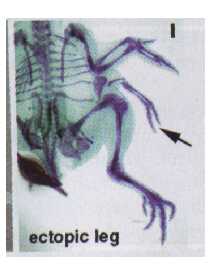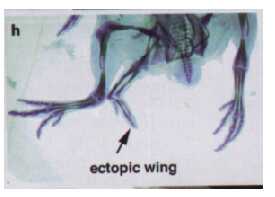Research Paper Synopsis for
Principles of Animal Development
The Animal Development Class
Dictionary
The article discussed at this site was written by Takeuchi et al (1999) and is titled: Tbx5 and Tbx4 genes determine the wing/leg identity of limb buds.
It was shown by the authors that the differential expression of Tbx4 and Tbx5 in the legs and wing buds, respectively, are the determining factors in identifying limb bud identity. Therefore, when Tbx4 is expressed in limb buds, its gene product influences other factors in a cascade leading to the development of bones, and other structures characteristic of legs, whereas the Tbx5 protein influences the same cascade, however with a different result; the genetic cascade leads to the development of bones and likewise structures characteristic of wings.
The authors implemented a novel experimental design where retroviral plasmids containing the gene of choice are electroporated directly into the limb field. Thus, misexpression of the T-Box genes (ie: Tbx5 in leg fields and Tbx4 in wings) leads to a series of events with the end results being:
- Ectopic Tbx4 leads to the development of a partial skeletal leg pattern with four toes, complete with claws, and feather-to-scale conversion.
- Ectopic Tbx5 leads to the development of a partial skeletal wing pattern, including elongation of the fibula with articulation to the metatarsals, three digits, and scale-to-feather conversion.
 |
 |
| Figure 1. Grafting of presumptive wing cells into the coelom of the host embryo results in ectopic wing development. (Rodriguez-Esteban 1999) |
Figure 2. Grafting of presumptive wing cells infected RCASBP-Tbx4 induces the formation of an ectopic limb with leg characteristics. (Rodriguez-Esteban 1999) |
In addition, there are many other genes that influence the action of the T-Box genes including Pitx1, the Hox genes, and the FGF's. The Hox genes are thought to be expressed prior to the expression of the T-Box genes, thus serving some role in the initiation of their expression and, thus limb identification. As it can be seen, there are a great deal of genetic interactions taking place in limb development.
The origin of limb bud tissue was found to be composed of the convergence of lateral plate mesoderm and somitic mesoderm, where combined with ectodermal tissue, the AER forms. The AER then serves to play a part in the formation of the organizer, ZPA. These structures are integral in setting down the original body plans including the anterior/posterior axis and proximal/distal limb patterning.
To have a greater understanding of what goes on in limb identification (and subsequent development), including the genetic interactions, the actions of the T-Box genes on development, and my discussions on the research article, feel free to explore these pages.
Go to:
Gene Interactions
Discussion
T-Box genes
Methods
Glossary
References
Go to the

Top


